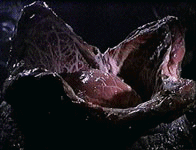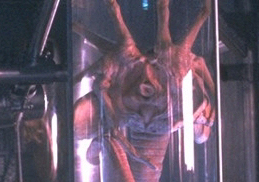THE LIFE CYCLE
 |
THE
EGG The Egg is
roughly one meter in height and two feet wide with four |

|
THE
PARASITIC PHASE The
Facehugger is roughly one and a half meters in length |
 |
The
Chestburster Phase Phase 3 is known as the "Chestburster" a few hours after the facehugger has died the "Chestburster" awakes and escapes from it's host by the quickest exit point. In a human this is through the sternum. The creature explodes through the ribs and tissue and finds a warm damp environment in order to quickly grow into a full size creature. The Chestburster moves by using its tail to push itself along. It's metabolism id higher than any creature we have seen before as it take three hours for it to reach full size |

|
The
Xenomorph Warrior (human host) This is the most common creature that we have encountered a researched. This variant of the creature is smarter than others encountered and uses stealthier tactics when in combat. The Warriors are the loyal subjects of the queen who has control over them all much like an ant queen they communicate by the use of pheromones and a telepathic ability. We have yet to find ways to manipulate the telepathy to our advantage but we are close to a major breakthrough. The human creature is generally bipedal due to
the human DNA. The Adult Xenomorph posses the ability to climb on walls and
ceilings. The creature has four spine like appendages extending from its back these
contain glands that secret a resin which is used to construct a hive. The secondary jaws of the Alien which are part of a modified tongue are
used in an offensive manner and can spring twelve inches outward from the Xenomorph's
mouth. The second set of jaws primary purpose is immobilizing a potential |
 |
The Adult Xenomorph has many variations dependant on the host organism. The creature"born" from a dog is much faster and agile than the human version. There have been a few sightings of a creature much larger than ant other which is both stronger and quicker many marines and scientists alike have a suspicion that this is a predator hybrid. We are in the process of trying to gather a specimen for research. |
 |
From new research it has been uncovered that there is a much larger alien creature which is used as a "Royal Guard" these creatures are created when a Chestburster is treated with ROYAL JELLY and then matures into a larger creature. These are only found in the queens chamber and are not used as an offensive measure but only to defend the queen. |

|
THE
QUEEN The
Queen is about four and one half meters tall with an extremely powerful tail that is equal
in length to the Queen's height. It possesses a large cranial crown which extends two
meters behind the back of its head, and it has a second set of smaller arms. The Queen's
head is kept hidden in its cranium until awakened in which at that time it will emerge
much like a turtle This is used to extent the range of the queens telepathic abilities to
the hive and surrounding area. The total distance of control has yet to be
determined. The secondary jaws of the Queen are just like the Adult's secondary jaws
except they're proportionately bigger with a striking length of |





